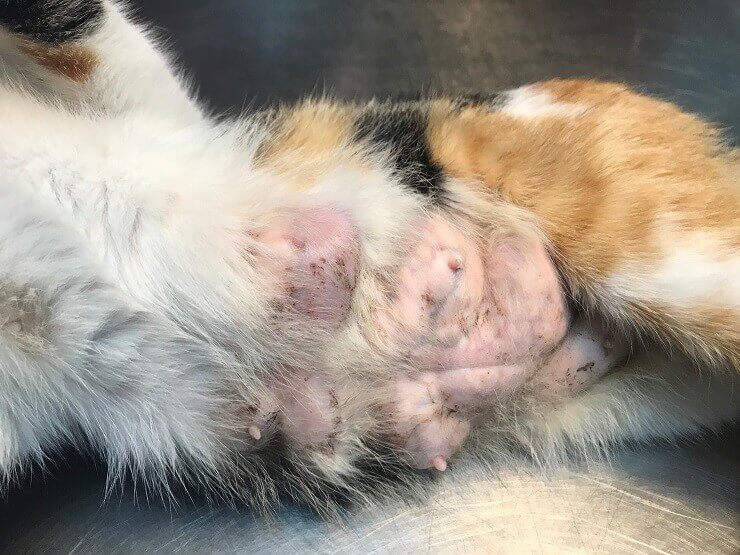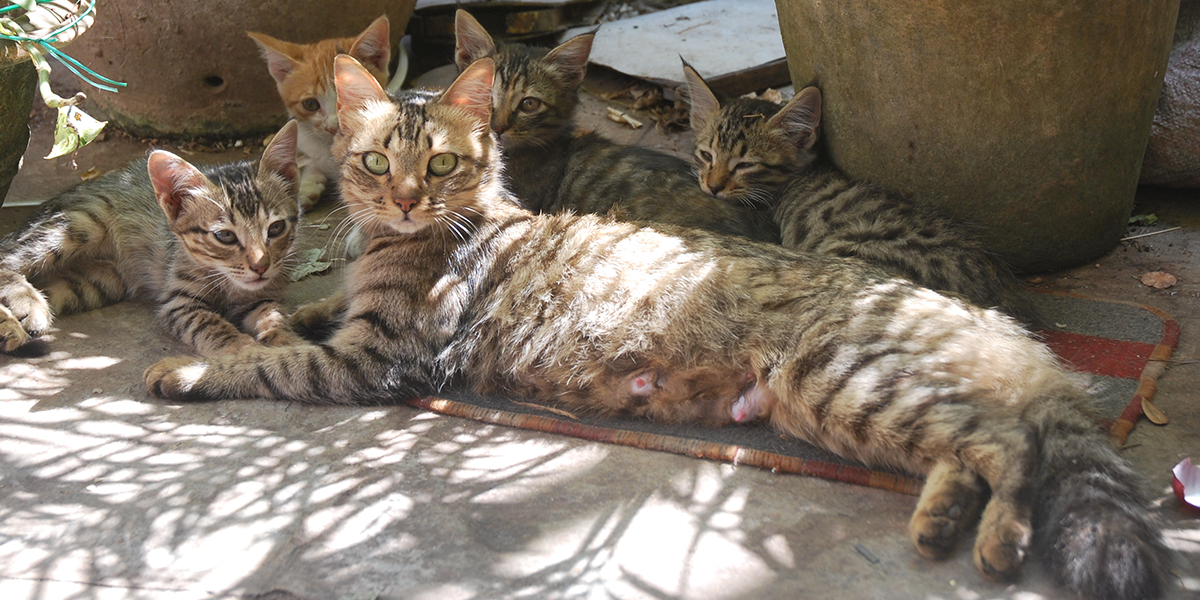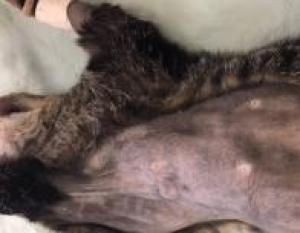mammary adenocarcinoma in cats
Reluctance to remain active. Feline mammary gland tumors are the 3 rd most common feline tumor and are most commonly diagnosed in middle-aged to older cats.

A Clinical Manifestation Of Mammary Fibroadenomatous Hyperplasia B Download Scientific Diagram
Mammary cancer is usually a malignant adenocarcinoma that appears in one or more of a cats breasts.

. Approximately 85 of feline mammary tumors are malignant and are histologically classified as adenocarcinomas. Feline mammary tumors are mostly adenocarcinomas Hayes et al 1981 and the least common carcinomas are tumors with differentiation of squamous cells. In cats mammary gland cancer is the equivalent of breast cancer in women.
Cancer is treated using three types of therapy surgery chemotherapy and radiation therapy. Anaplastic giant cell mammary carcinoma is not frequent and has only been reported in. Scott Coonrod the Judy Wilpon Professor of Cancer Biology and director of the Baker Institute for Animal Health.
Cancer in general afflicts an estimated 30 percent to 40 percent of all cats and one-third or so of these malignancies involve the mammary glands. 78 These prolonged survival times have not been reproduced by later studies. They run the length of a cats belly which means that tumors can develop anywhere from the armpit to the groin says Dr.
Mammary tumors in cats are usually malignant 85-93 80 of feline mammary tumors are ADC with tubular papillary solid and cribriform subtypes most common. Histologic grading of these tumors is achieved using the Elston and Ellis. Hundreds of remedies for the most common pet ailments.
Mammary cancer in cats Treatment. And they may occur in. Feline Mammary Gland Adenocarcinoma.
Sarcomas mucinous carcinomas duct papillomas adenosquamous carcinomas and adenomas are rarely seen. A combination of these or two of them can be used. At a cellular level mammary tumors in dogs and cats are very similar to human breast cancer tumors says Dr.
These two forms of the disease have different diagnostics treatments management and prognosis. These tumors may originate in the mammary gland but they can metastasize to the lymph nodes adrenal gland lungs liver pleura and kidneys. Symptoms of Cat Mammary Gland Tumors The most common symptom of a cat mammary gland tumor is a lump or swelling along the cats mammary chain which is the line of breast tissue and nipples along your cat.
A mammary breast tumor is a common tumor in cats. Females as well as males can develop this form of cancer. Mammary gland tumors are most common in middle-aged and older female cats but they can occur in younger female cats as well as male cats.
Feline mammary carcinoma is highly malignant and generally associated with a poor prognosis although studies suggest the range of survival times in affected cats is broad. Invasion ulceration lymphatic invasion and lymph node metastasis is common. In cats the vast majority of mammary tumors are malignant.
Cats have two chains or rows of mammary glands with four in each chain. Place your order today. Incidence of mammary tumors is dependent on when cats are spayed.
The efficacy of a treatment combination of a COX-2 inhibitor meloxicam chemotherapy and surgery in 23 cats with histologically confirmed mammary gland adenocarcinoma was evaluated. Mucus in the stool. Symptoms of adenocarcinoma in cats depend on where in the body the tumor has developed.
All of the cases underwent an aggressive surgery with concurrent doxorubicin-based chemotherapy. Sarcoma SCC and mucinous carcinoma subtypes are less common. Ad Provide your pet with the care he needs.
Meloxicam was given orally starting the day after surgery and was continued. The first sign of this type of cancer may be a fluid-filled or firm lump associated with the mammary gland or discharge originating from the nipple. If you have the following possible signs of cancer you should take your cat to the vet immediately.
Approximately 90 of mammary tumors are malignant in cats and cats have fewer complex and mixed tumors than dogs. Weight loss Loss of appetite or conversely an abnormally large appetite Difficulty eating or swallowing Vomiting Diarrhea Seizures Epileptic seizures Anemia Wounds that do not. Another type of adenocarcinoma affects female cats.
Other forms of breast and mammary cancer in a cat include adenomas duct papillomas and sarcomas. Anaplastic carcinoma appears as an infiltrative neoplasm formed by large pleomorphic cells frequently with bizarre chromatin-rich nuclei with the presence of multinucleated cells. Mammary tumors are the third most common feline cancer 1-3 accounting for 103 to 12 of all diagnosed tumors.
There are several different types of mammary tumors with carcinomas being the most common. Mammary tumors can be benign non-cancerous or malignant cancerous. On histopathologic evaluation tumors from all 107 cats were identified as mammary carcinomas and most were labeled adenocarcinoma.
Carcinomas often arise from the tubules of. In cats with mammary tumors approximately 90 are malignant with rapid spread to adjacent glands and the nearest set of lymph nodes. Malignant mammary tumors.
Most feline mammary tumors are adenocarcinomas with tubular or papillary types more common than solid or mucoid types. Biologic behavior prognostic factors and therapeutic approach in cats. There are also differences in both biologic behavior and histology of mammary tumors in dogs and cats.
If your cat is spayed the odds of developing mammary cancer are extremely low as long as she was spayed before the age of 2. Localized pain or discomfort Palpable growth. For example if the cat suffers from a malignant neoplasm but it hasnt spread to any organ chemotherapy might be initiated before the mass is removed surgically.
Tumors originating in these glands account for the third most common type of feline cancer after lymphoma and skin cancer. Tumor size is one of the most consistent prognostic factors in feline mammary carcinoma. Occurring more than 95 percent of the time in females it is the most frequently diagnosed type of feline cancer.
Blood in the stool. Mammary tumors are the third most common feline cancer1-3 accounting for 103 to 12 of all diagnosed tumors124 Female cats are. When it appears in cats it can be fatal even if treated with surgery radiation and chemotherapy.
These masses do not tend to be painful but can be associated with increased grooming behavior if discharge is present. Cats who are spayed prior to 6 months of age have a 91 reduced risk of developing mammary cancer. The most common adenocarcinoma-associated symptoms in cats include.
Cats with tumors less than 2 cm or 8 cm 3 can have an excellent long term survival 3 years if treated with surgery alone radical mastectomy according to a prospective and retrospective studies in cats. As the study spanned 23 years in multiple institutions histopathologic assessment was not uniform and this made it impossible to further classify the tumors by histopathologic grade or subtype.

Stages Of Breast Cancer In Cats Mammary Tumors In Cats

Cat Breast Cancer Causes Symptoms And Treatment Of Mammary Cancer

Mammary Carcinoma International Cat Care

Spotlight On Feline Mammary Cancer Dr Sue Cancer Vet Facebook

Feline Mammary Cancer Mammary Tumors Common In Cats Especially Those Unspayed Or Spayed Late In Life Naples Florida Weekly

Cat Breast Cancer Causes Symptoms And Treatment Of Mammary Cancer

Breast Cancer In Cats Causes Symptoms Treatment All About Cats

Victoria Stilwell October Is Breast Cancer Awareness Month Did You Know That Cats And Dogs Especially Intact Females Are Susceptible To Mammary Cancer As Well This Is A Great Graphic From
